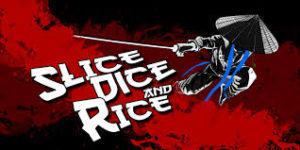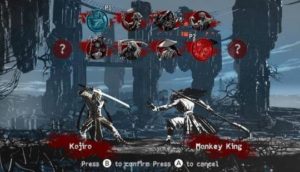
As many of you know, I love fighting games. There is not a more healthy way to release stress than with a good video game fight. For many years now, game developers have tried to shake up the formula, adding cool and sometimes complicated mechanics and systems. Most fighting games nowadays are more focused on giving the user a lot of tools to deal massive amounts of damage, such as chain combos, special attacks, air combo dashes, and super or even hyper combos. I won’t complain about them, since they look really good. Besides, some developers do take the time to create a tutorial of sorts to make newcomers understand and enjoy the game (for example, Arc System Works creates the best and most comprehensive tutorials to date, period). But what would happen if a game decided to throw away the usual elements of a fighting game like health bars? What would happen if instead of a 50, 60 or 100 hit combo only a well placed attack would be all needed to decide the outcome? Well, Slice Dice and Rice has the answer to those questions, since this is a no health bars fighting game that pits samurai and other interesting characters against each other in a series of one hit kill duels all in the style of classic Japanese flicks of old.

In SDR, you have eight different characters. If you are a little into Japanese culture, you will recognize some names (Son Goku wink wink). If not, knowing who they are is not super important. What matters is that the differences in each character. Their respective weapons and game play style make for some heated and interesting matches. For example, putting the fast moving Tengu against the spear wielding Monkey King is sure to make you think. Since each fight becomes a battle of wits and baits, knowing when to dash or when to parry an attack is what makes each battle so exciting. Each character has the same attacks: a quick horizontal slash, a powerful heavy attack that can’t be parried, and an anti-air vertical slash. Everyone can jump, air-dash, parry, as well as dash-cancel or parry-cancel their attacks before they come out. There is even “Unagi”(remember Ross from Friends). When you are about to receive an attack, the game slows down and a red circle appears on your character, giving you the chance to evade or counter attack. However, the timing must be perfect (pro tip: evade is easier to counter attack this way), or you will see your character being shred to pieces.
The Story mode puts the character you choose in a series of fights (at first only Kojiro is available; the rest are unlocked as you play the story mode). There are also more powerful versions of existing characters (in the form of boss fights), so there is variety of characters and play styles. However, it’s not all the time that the fights end in one hit kills because position takes a important role in this game. If your opponent dashes back and the tip of your sword hits, he won’t be killed, but he will be wounded. Successive wounds will affect the opponent’s ability to jump, giving you an “edge” on the fight. Parry is really useful also, since it gives you some frames of advantage to counter attack. However, the other player can also do a well-timed parry, and the outcome could be decided. There is a saying in my country, “The one who strikes first, hits twice.” I believe that it can be applied to SDR.

Graphically, I like how the character models look, especially with the minimalistic approach taken in regards to how colorful they are. The black and white shades really highlight the blood (it reminds me a lot of the style of the Wii-era game, Madworld). Each area you fight is well-detailed and goes well with the theme of bloody fights to the death.
The music is good and–like expected–there is a lot of tunes reminiscent of the era portrayed.
The only issue I have encountered so far is that sometimes there are some performance issues. When you are attacking, there are some slight hiccups. In a game where the first strike could be the last, this affects the game play since when you least expect it, a blade is beheading your character (it doesn’t happen all the time but is annoying). This is more frustrating when you only have one “round” left to win.
Online game play is implemented, and it is good to duke it out against other gamers looking for the definitive duel. Aside from the performance issues explained above, my fights were smooth (I lost a lot, by the way).
Bottom Line: Slice, Dice and Rice is a fighting game unlike others. It not only requires quick reflexes but also strategy in each fight. The game is like fencing but with blood and body parts flying. If you want to experience something different, I can recommend it. And even with the slight performance issues, it can still be fun.
A Review Code was provided for this review.

